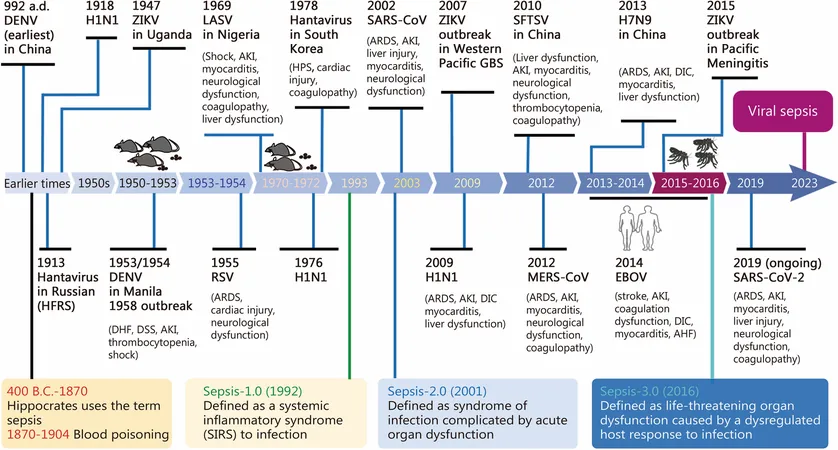
Unmasking Viral Sepsis: How It Hijacks Immune Responses, Causes Organ Damage, and What You Need to Know
2024-12-16
Author: Jia
Understanding Viral Immune Evasion
Upon viral invasion, the immune system’s PRRs (pattern recognition receptors) like Toll-like receptors (TLRs), NOD-like receptors (NLRs), and RIG-I-like receptors play crucial roles in identifying viral components. This detection initiates a cascade to produce type I interferons (IFNs) which aim to eliminate the virus. However, in cases of viral sepsis, this process can become dysfunctional. Such malfunction not only hampers viral clearance but can also facilitate viral escape from immune responses, ultimately inducing further tissue injury.
The Role of TLRs
TLRs, of which there are ten types, serve as a frontline defense. They detect viral components—TLR3 responds to double-stranded RNA, while TLR7 and TLR8 detect single-stranded RNA from viruses like influenza and coronaviruses. Unfortunately, numerous viruses—including SARS-CoV-2—can manipulate TLR signaling pathways, hindering effective immune responses and enhancing their replication.
NLRs and Their Functionality
NLRs are another class of receptors that detect viral activity, triggering antiviral responses. They can activate critical pathways, such as during infections with respiratory viruses like RSV and influenza, to produce IFN-β, a vital component of the antiviral defense. However, virulent strains can exploit these pathways to further their survival and evade immune detection.
Impact of RLRs in Viral Infections
RIG-I-like receptors (RLRs) such as RIG-I and MDA5 are pivotal for recognizing viral RNA and initiating immune responses. These receptors interact with mitochondrial antiviral signaling (MAVS) proteins to activate pathways leading to the generation of type I IFNs. This response is crucial, especially during COVID-19, where RLR signaling is directly correlating with disease severity.
cGAS-STING Pathway: A Double-Edged Sword
The cGAS-STING pathway represents a significant system in detecting viral DNA and initiating immune responses. While it offers protection, it can also lead to overwhelming inflammatory responses that exacerbate organ damage, particularly observed in severe cases of COVID-19 and other viral infections.
Consequences of Cellular Stress
Viral infections can induce severe cellular stress responses, leading to a cascade of harmful effects including endoplasmic reticulum (ER) stress and mitochondrial dysfunction. Viral proteins can activate pathways that worsen inflammation and contribute to organ injury, underscoring the complex interplay between viral replication and host immune defense.
The Deadly Game of Cell Death
Viral infections employ various cell death pathways such as apoptosis, pyroptosis, and necroptosis. While these mechanisms aim to curtail viral spread, excessive activation can be detrimental, resulting in the death of immune cells, which contributes to immunosuppression, increased susceptibility to secondary infections, and ultimately, organ failure.
Cytokine Storms: The Inflammatory Disaster
The release of cytokines during viral infection can spiral out of control, leading to a 'cytokine storm.' Elevated levels of IL-1β, IL-6, and TNF can disrupt the delicate balance within the alveolar-capillary interface, leading to severe pulmonary complications such as acute respiratory distress syndrome (ARDS). The phenomenon is particularly evident in severe cases of COVID-19 where the inflammatory reaction can be catastrophic.
A Multifaceted Approach to Treatment
Currently, the management of viral sepsis is challenging due to the lack of specific antiviral medications. Instead, treatment is largely supportive, focusing on restoring vital functions and managing complications. Interventions like fluid resuscitation, mechanical ventilation, and renal replacement therapy play a critical role in patient management.
Innovative Treatment Strategies
Exploring novel treatment options such as convalescent plasma therapy, immunomodulation, and direct antiviral strategies has shown promise. For instance, recent studies have indicated that drugs like remdesivir and nirmatrelvir, which target viral replication mechanisms, can reduce disease severity in patients with COVID-19.
Tee Up for the Future: The Importance of Research
While advancements in managing viral sepsis continue to evolve, the complexities of the disease underscore the importance of ongoing research. Understanding the myriad pathways involved in viral pathogenesis is crucial for developing targeted therapies and improving patient outcomes.
Conclusion
In conclusion, viral sepsis represents a multifaceted challenge that not only showcases the resilience of viral pathogens but also highlights the limits of our current medical interventions. The journey towards effective treatment requires an integrative approach, combining innovative therapies, supportive care, and a greater understanding of viral mechanisms to turn the tide against these opportunistic infections. Stay informed, and remain vigilant, as the battle against viral sepsis continues to unfold.


 Brasil (PT)
Brasil (PT)
 Canada (EN)
Canada (EN)
 Chile (ES)
Chile (ES)
 España (ES)
España (ES)
 France (FR)
France (FR)
 Hong Kong (EN)
Hong Kong (EN)
 Italia (IT)
Italia (IT)
 日本 (JA)
日本 (JA)
 Magyarország (HU)
Magyarország (HU)
 Norge (NO)
Norge (NO)
 Polska (PL)
Polska (PL)
 Schweiz (DE)
Schweiz (DE)
 Singapore (EN)
Singapore (EN)
 Sverige (SV)
Sverige (SV)
 Suomi (FI)
Suomi (FI)
 Türkiye (TR)
Türkiye (TR)